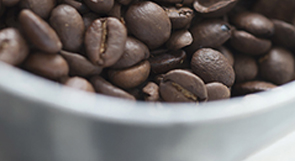Every Hardy brand has its own personality and a cup coffee can become a voyage of discovery for the palate.
It just takes one sip of the Hardy Milano blend to perceive the bittersweet of dark chocolate, while a taste of Hardy Universo immediately brings to mind the fragrance of a freshly picked licorice.
Aromas, flavours and images all contribute to creating the synaesthesia of taste: the area of blurred borders poised between objectivity and subjectivity, between chemistry and sentiment.
Five flavours add up to an infinite number of combinations
According to the Encyclopaedia Treccani, taste is the sense enabling us to recognize and monitor the substances we put into our oral cavities. In fact, our tongue is covered with taste buds, cellular structures able to identify the principal flavours: bitter, sour, salty, sweet and the umami (which in Japanese means “tasty” ) flavour typical of glutamate, to be found in foods that are high in protein such as meat and cheese. By combining these five flavours, it is possible to create more complex combinations which have been studied down through the centuries, to develop a never ending source of new recipes.
Why do we like one thing rather than another
As soon as we eat something, the cells on our tongue analyze the chemical composition of the food and send this information to the brain which, as always, counts on its sensorial experience to tell us what our body needs and what it has to avoid.
For instance, an excessively bitter flavour provokes an instinctive sensation of disgust, because this taste often characterizes poisonous plants or harmful substances. Conversely, the sweetness of sugar substances invites us to eat the carbohydrates we need. It is no coincidence that taste is the sense we develop most rapidly in life and, when we are very young, it represents an important way to discover the world around us: babies no more than a few months old instinctively put everything into their mouths, even before they look at it or feel it.
Why do people’s tastes differ
The tasting experience takes us far beyond the immediacy of everyday life and survival. The chemical analysis carried out by our taste buds is backed up by the intuition of our sense of smell which melds the present and its objectivity with our memory and inner feelings. While the taste receptors on our tongue translate soluble substances into nervous impulses, our sense of smell manages to perceive the volatile substances which cause us to react in a way that is both elusive and immediate. For example, if someone smells the aroma of the Hardy Europa blend and perceives hints of wood and earth, he may be reminded of the rough surface of tree bark, while someone else may recall his childhood holidays and walks taken along mountain paths. Suggestions and recollections associated with our habits and cultural background contribute to shaping our preferences. For this reason, taste is a very personal matter.
Taste education
Tasting a new recipe or a cuisine that is very different from their own provokes different reactions in different people, similarly to any other change in life: some refuse it, others are wary, some are curious while others can’t wait to try. Even though some individuals have a real talent for perceiving the tiniest nuances of a food or drink, we can all educate our sense of taste. To learn to distinguish the Hardy coffee blends, you have to focus on the aroma, by closing your eyes and paying great attention to fragrance and scents; then comes the actual tasting experience when you have to look out for acidity, creaminess and bitterness. Finally, it is necessary to consider the aftertaste: it could reveal some quite unexpected notes.



